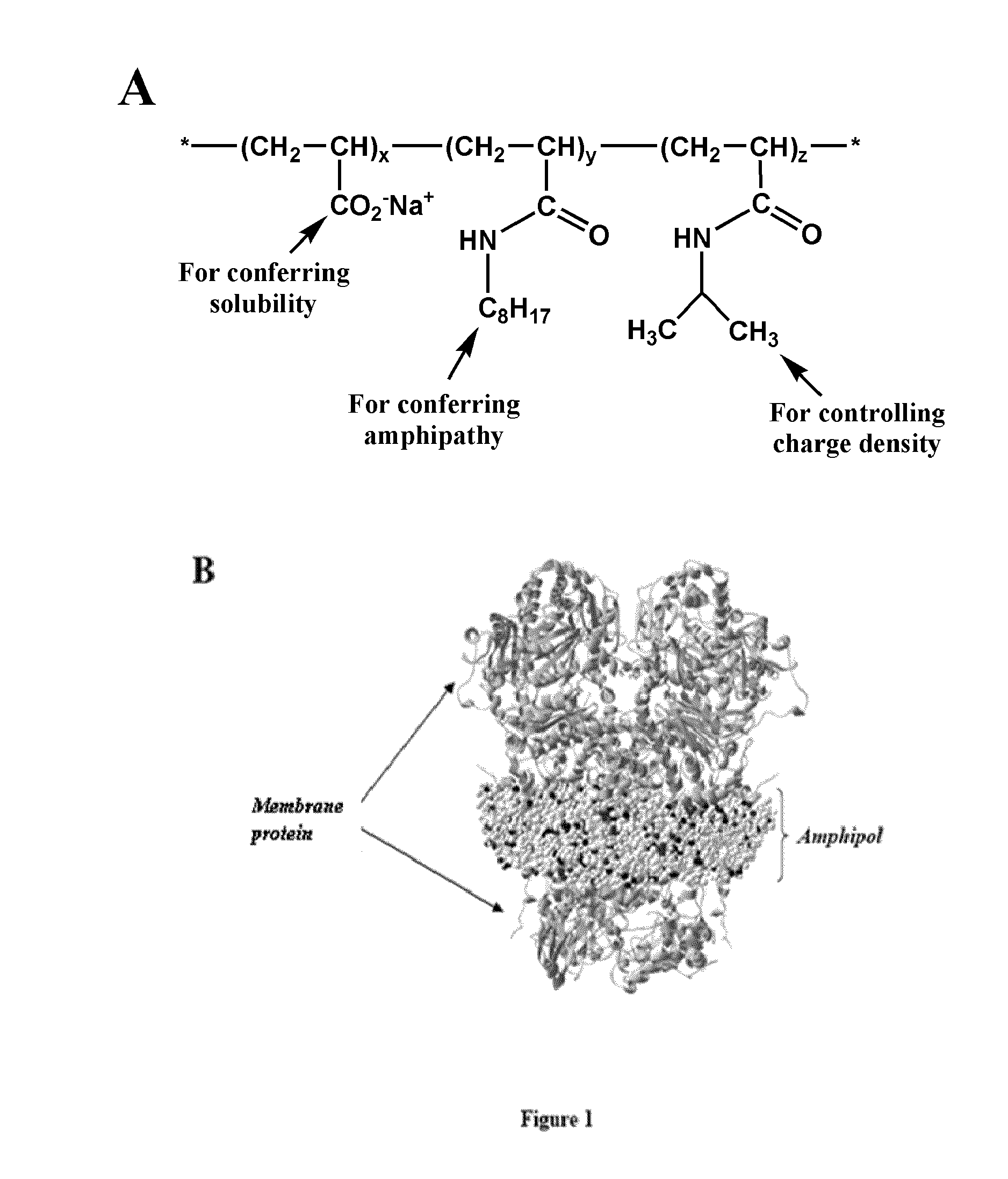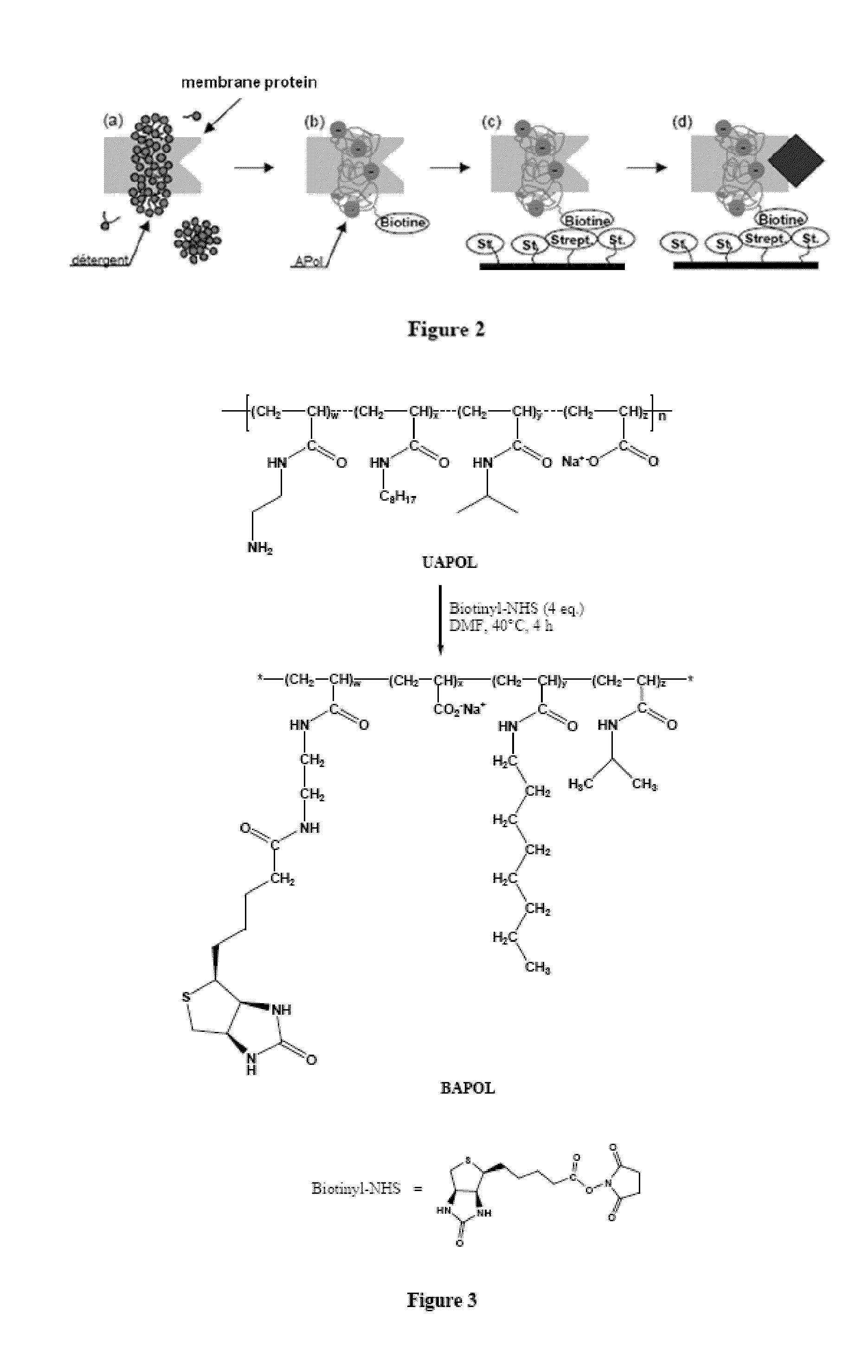Immobilization of membrane proteins onto supports via an amphiphile
a technology of membrane proteins and amphiphiles, which is applied in the preparation of sugar derivatives, peptides, enzymology, etc., can solve the problems of difficult or impossible implementation, difficult or impossible to handle for membrane proteins about which little information is available, and more complex membrane proteins
- Summary
- Abstract
- Description
- Claims
- Application Information
AI Technical Summary
Benefits of technology
Problems solved by technology
Method used
Image
Examples
example 1
Membrane Protein Immobilization at the Surface of Streptavidin-Carrying Chips by Means of a Biotinylated Amphipol
[0256]1.1 Principle
[0257]The experimental principle developed for immobilizing membrane proteins at the surface of solid supports is the following (FIG. 2): the membrane protein is solubilized in a detergent (step a) then trapped with a biotinylated amphipol and the detergent is removed (step b); the resulting complex is contacted with a support grafted with streptavidin groups with which it can be combined via a specific biotin / streptavidin interaction (step c). A protein ligand can then be circulated on the support and the ligand / protein interaction can be studied (step d).
[0258]Immobilization was experimentally monitored by a surface plasmon resonance (SPR) technique. This technique allows detection and real-time monitoring of interactions between circulating molecules and one or more immobilized molecule(s), by continuously observing for a change in surface plasmon re...
example 2
Membrane Protein Immobilization at the Surface of Streptavidin-Carrying Magnetic Beads by Means of a Biotinylated Amphipol
[0297]The inventors tested bacteriorhodopsin (BR) immobilization on magnetic beads functionalized by binding to streptavidin (SA beads).
[0298]BR was complexed with biotinylated amphipol (BAPol) according to the following method: a BR solution in octyl thioglucoside detergent (OTG) contains 1.1 g / l protein, 18 mM OTG. 17 μl of a 100 g / l BAPol solution in water are added to 300 μl of protein solution (i.e. 5 g of BAPol per g of BR). After incubation for 15 min, 80 mg of Bio-beads are added and incubation is left to proceed under stirring for 3 hr at 4° C. (adsorption of OTG) followed by recovery of the solution and removal of the Bio-beads.
[0299]100 mg of SA beads were washed 3 times in NaCl-HEPES buffer (150 mM NaCl, 10 mM HEPES at pH 7.4), then excess liquid was removed; the protein solution was diluted to 13 mg / L in NaCl-HEPES buffer.
[0300]At time zero, the prot...
example 3
Synthesis of a Polyhistidine-Labelled Amphipol (HISTAPol)
[0303]The structure of biotinylated amphipol (BAPol) is described in FIG. 3.
[0304]The method for synthesizing polyhistidine-labelled amphipol (HISTAPol) is derived from the method for non-functionalized amphipols (7, 16-17) and comprises three steps.
[0305]The first step comprises forming amide bonds with the carboxylic acid functionalities of a low molecular weight polyacrylic acid and appropriately selected alkylamines, such as isopropylamine and octylamine.
[0306]The second step involves work-up of a histidine hexamer. This synthesis is carried out on a solid support using an automated technique involving double coupling of the selectively protected monomer.
[0307]The last step comprises condensing the peptide N-termination onto the acid functionalities of the amphipol resulting from the first step of the synthesis. The peptide is used while still protected on its side chains and bound to the solid support. The amounts of amph...
PUM
| Property | Measurement | Unit |
|---|---|---|
| pH | aaaaa | aaaaa |
| time | aaaaa | aaaaa |
| amphiphilic | aaaaa | aaaaa |
Abstract
Description
Claims
Application Information
 Login to View More
Login to View More - R&D
- Intellectual Property
- Life Sciences
- Materials
- Tech Scout
- Unparalleled Data Quality
- Higher Quality Content
- 60% Fewer Hallucinations
Browse by: Latest US Patents, China's latest patents, Technical Efficacy Thesaurus, Application Domain, Technology Topic, Popular Technical Reports.
© 2025 PatSnap. All rights reserved.Legal|Privacy policy|Modern Slavery Act Transparency Statement|Sitemap|About US| Contact US: help@patsnap.com



